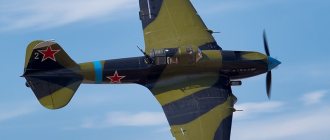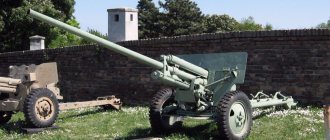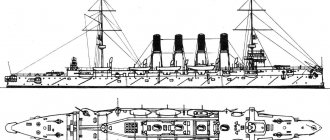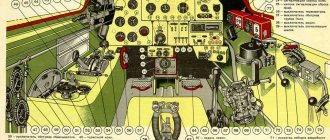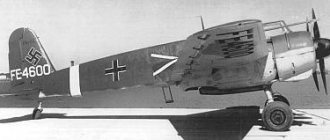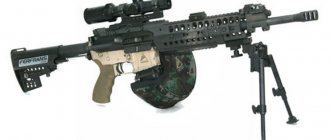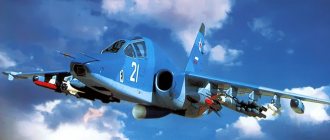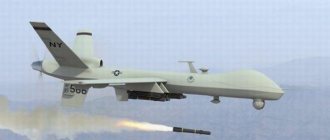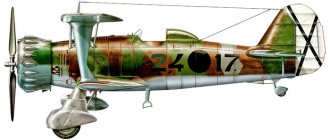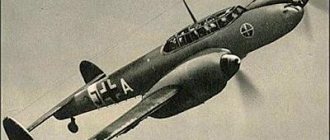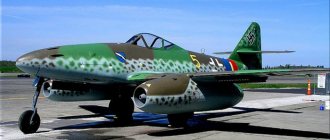History of the creation of the attack aircraft
During World War II, USSR aviation demonstrated serious superiority over its foreign counterparts. A particularly strong gap was noticeable in the attack aircraft class. Il-2 and Il-10 caused real fear among German soldiers and received the nickname “Black Death”.
After this, attack aircraft were to become the main component of the air force. But its development was suddenly destroyed by the creation of new mobile air defense systems and advanced helicopters that could easily attack enemy formations, flying at low altitude and hovering in the air.
Already by 1956, the leadership of the USSR decided that the era of attack aircraft had come to an end, and abolished the entire class. At that time, the Ilyushin Design Bureau was developing a new attack aircraft, the Il-40, which had passed factory tests a year earlier and was already ready for mass production. The government's decision resulted in five test samples being dismantled.
The abandonment of the use of attack aircraft occurred throughout the world. But the very first military actions showed that the decision was hasty. Helicopters, on which great hopes were placed, were ineffective and could only be fully used to deliver soldiers with fire support.
Attempts to replace attack aircraft with fighter-bombers also did not lead to the desired results. Therefore, by the mid-1960s, many countries, including the USSR, decided to return to the operation of attack aircraft.
All major design bureaus began creating new attack aircraft at once, and the leadership among them was taken by the enterprise of P. O. Sukhoi. The project under development had great prospects and was superior to most analogues.
The Ilyushin Design Bureau decided to take advantage of the developments and by the end of the 1960s offered the air force its own version of the aircraft called the Il-42, which was a serious modification of the Il-40. It was assumed that it would receive two AM-5F engines, be able to carry up to 1,400 kg of combat load and accelerate to 997 km/h with the ability to climb up to 11,600 m.
In 1969, the government organized a competition to choose the best attack aircraft. The Il-42 took part, as well as three aircraft from other bureaus: the Yak-25LSH, MiG-21LSH and T-8. The winners of the competition were the MiG-21LSh and the T-8, which later received the name Su-25.
Projects to develop the Il-42 with the Yak-25LSh were closed. The designers from Ilyushin’s company were not going to give up their plans. Therefore, it was continued, and G.V. Novozhilov acted as the leader of the group.
The plane became known as Il-102. Development proceeded at a slow pace, which was partly due to a lack of funding and not entirely legal status. The Ministry of Defense spoke out against the creation of an attack aircraft by the enterprise and called the project a senseless waste of energy. Despite such problems, by 1982, Ilyushin's bureau demonstrated a prototype of the Il 102, which was supposed to pass all tests in the shortest possible time.
IL-102 Dimensions. Engine. Weight. Story. Range of flight. Service ceiling
Creation of the third generation attack aircraft Il-102 at the S.V. Ilyushin began almost simultaneously with the same work at the P.O. Sukhoi. Each of them had his own view on the prospects for the combat use of the future attack aircraft. Specialists from OKB P.O. Sukhoi designed a single-seat aircraft. Team S.V. Ilyushin remained true to tradition, having experience in creating the Il-2 attack aircraft, as well as the Il-40 attack aircraft created in 1953. But the team was not only guided by tradition when creating the machine; such a scheme is deeply justified and is by no means outdated.
Flight and performance characteristics of the Il-102
The presented Il-102 had standard dimensions for an attack aircraft. The length was 17.75 m with a height of 5.08 m. The wing span was elongated by 16.9 m, its area was 63.5 m². The empty weight of the aircraft did not exceed 13 tons, the normal weight for takeoff was 18 tons, and the maximum was limited to 22 tons. The fuel in the main tanks weighed 3700 kg, in the outboard tanks - 1930 kg.
The Il-102 operated on two RD-33I engines, which produced thrust up to 5320 kgf. The plane's speed was limited to 950 km/h. When taking off, it needed to be accelerated to 150 km/h, and when landing, it needed to be slowed down to 180 km/h. The takeoff length was 300 m, the mileage reached 450 m. The flight range seriously depended on the type of departure. When ferrying, the plane could fly 3000 km.
The practical distance was set at 1000 km; at high speed it was reduced to 750 km. The combat radius of use was limited to 400 km. The maximum flight altitude was up to 11,000 m.
The fate of the IL-20
It is unknown what the fate of this aircraft would have been if it had not appeared on the very threshold of the jet age, or if it had appeared even a little earlier. As for the Second World War, the car turned out to be very powerful, but, naturally, it could not compete with jet aircraft.
The Il-20 heavy attack aircraft was built in one copy and carried out several flights. During which it was possible to reach a maximum speed of 515 km/h (like the Il-10M), show a maximum climb time of 3000 m - 8 minutes, a ceiling of 7750 m and a flight range of 1180 km with a normal bomb load. This is where the story of this slightly late plane ended.
Scheme of the Il-20 attack aircraft
Aircraft design
When developing the Il-102, a classic aerodynamic design was used. Most of the cladding was technologically created from sheets of single curvature. The fuselage type was semi-monocoque. Two pressurized cabins were installed in its central part. One was intended for the pilot, the second for the gunner. In the middle between them there were internal fuel tanks. There were aerodynamic brakes in the tail.
The wing belonged to the low-lying type and was swept two-spar. Its design used a thickened profile. Inside there were special compartments for loading bomb weapons. The flaps occupied more than half the wing span. Interceptors with two sections were installed on the upper surface.
The chassis was standard with three two-wheel legs equipped with low-pressure pneumatic elements. An important advantage of the aircraft was the ability to land on unprepared unprepared runways.
The front support was mounted at the very beginning of the fuselage and retracted inside, which eliminated the possibility of using electronic equipment or radar devices in the pocket. The other two struts were located closer to the middle of the hull, and during takeoff they folded into the wing nacelles.
The power plant consisted of two RD-33I engines, providing thrust up to 5320 kgf. They had air intakes with a circular cross-section. The aircraft was transported exclusively in a disassembled state using rail transport or an Il-76 cargo truck.
Il-102 cockpit
The pressurized cabins of the pilot and the gunner were separated from each other; their canopies consisted of flat armored glass, providing protection during air combat and shelling from the ground. The main safety system was ejection. It included special K-36L chairs and was synchronous. If the pilot activated it, he ejected immediately along with the shooter.
The final version of the cabin equipment was not approved, since the aircraft did not receive state order status. According to the designers' plans, the gunner's cockpit should have included the KPS-53A sighting system, as well as radar devices with special antennas.
The pilot's list of equipment included a S-17BTs model collimator sight, reconnaissance and detection installations, as well as various means of communication with command or other aircraft.
Stormtrooper weapons
It was planned to place a 9A-4071K cannon on board, equipped with ammunition for 500 30 mm caliber shells. It was supposed to be on a special carriage from the bottom of the fuselage and mechanically switch between turns in two directions. If the need arose, it could easily be replaced with a single external fuel tank or bomb shell.
At the rear of the fuselage there was a turret with a GSh-23L cannon of 23 mm caliber. It was assumed that it would be possible to accommodate an increased amount of ammunition, since the ammunition could be extended three meters to the bow compartment. The shells were supposed to be pulled up to the gun automatically using an electric belt pull-up mechanism.
The aircraft's bomb load could reach 7,200 kg, which made it possible to carry enough weapons to effectively conduct combat operations at the front. Special consoles with three compartments were installed on the wing, where bombs of various types weighing up to 250 kg were attached. Up to 2300 kg of weapons can be hung on the internal suspension elements.
There were 8 external units - three on each wing and two under the fuselage. Their ends were bent down and had blocks for releasing reflectors or special infrared traps. Several S-25L laser-guided missiles could be installed on the external suspension elements to carry out shelling of the ground, as well as to engage air targets or other types of unguided projectiles.
Have you seen the IL-102 attack aircraft in real life?
Not really
5:01 / 16.03.17 Heavy attack aircraft Il-102
IL-102
- Soviet experimental attack aircraft.
History
Developed at Ilyushin Design Bureau since the 1970s under the leadership of G.V. Novozhilov. It is a deep processing of the IL-40. The aircraft was built from May 1980 to January 1982, and made its first flight on September 25, 1982.
Il-102 - Soviet experimental attack aircraft / Photo: www.airwar.ru
The tests were carried out by honored test pilots S. G. Bliznyuk (Hero of the Soviet Union since 1990) and V. S. Belousov, having completed about 250 flights in 1982-1984.[1]
Genrikh Novozhilov / Photo: surfingbird.ru
In 1984, the aircraft was transferred for conservation, but in 1986 they tried to revive the topic, as a result, by December 29, 1987 (the date of the last flight), the total number of flights reached 367, and the flight time was about 249 hours [1]. The aircraft is designed according to a normal aerodynamic design. It passed flight tests well, but was not put into production for a number of reasons. The aircraft was exhibited at the Mosaeroshow-92 exhibition. In 2005, the car, which had previously been stored on the territory of the LII, was painted and installed on a pedestal on the Alley of Heroes near the LII Museum. Gromov, where it is currently located along with the monuments Su-17UM3, MiG-23UB, Yak-38U. Creation of the third generation attack aircraft Il-102 at the S.V. Ilyushin began almost simultaneously with the same work at the P.O. Sukhoi. Each of them had his own view on the prospects for the combat use of the future attack aircraft. Specialists from OKB P.O. Sukhoi designed a single-seat aircraft. Team S.V. Ilyushin remained faithful to traditions, having experience in creating the Il-2 attack aircraft, as well as the Il-40 attack aircraft created in 1953 [2]. But the team was not only guided by tradition when creating the machine; such a scheme is deeply justified and is by no means outdated.
Sturmovik Il-102 video
The gunner-operator, in addition to his main task - protection from attacks by fighters, combat helicopters and suppression of air defense systems - monitors the operation of a number of on-board systems. This greatly facilitates the pilot’s work and takes some of the burden off him, ensuring safety from attacks from behind. [3]
Model of the Il-40P attack aircraft / Photo: dishmodels.ru
The design of the machine, called Il-42, was ready by 1970, but the commission of the Ministry of Defense rejected it. Objections were caused by the high take-off weight, insufficient high maximum speed and two-seater cabin, which could lead to swelling of the Air Force staff and the opening of new schools for air gunners. According to the new requirements and in accordance with the comments, built by P.O. The Su-25 dry attack aircraft was recommended for mass production. Proactively, after introducing a number of changes, under the leadership of G.V. Novozhilov nevertheless decided to build a prototype of the aircraft to test the ideas contained in it. The plane was given the name Il-102.
Sturmovik Il-102 / Photo: www.airwar.ru
The design of the Il-102 aircraft was designed for extreme simplicity, manufacturability and low cost of serial production. For the first time, the OKB abandoned a single armored hull; the cockpits and partially the engines and fuel supply system are protected. To prevent a fire from breaking through fuel tanks, a system of filling them with polyurethane was used. The downward-bent wingtips are equipped with ejection units for IR traps and Avtomat-F dipole reflectors.
Ventral 30-mm cannon 9A-4071K on the Il-102 / Photo: www.airwar.ru
The aircraft's armament consists of a 9A-4071K double-barreled ventral mobile cannon mount for firing forward and a GSh-23 aft defensive mobile cannon mount, remotely controlled by a com-operator. The stern installation has an original ammunition supply system. The cartridge boxes, located almost three meters from the guns, are equipped with a special mechanism for electrically tightening the belt to maintain alignment when ammunition is consumed. The aircraft has 16 external hardpoints; in addition, the wing consoles have three bomb bays that can hold 250 kg bombs.
Guns of the Il-102 attack aircraft / Photo: kollektsiya.ru
The construction of the Il-102 aircraft without support from above progressed slowly, and yet by the beginning of 1982 the machine was ready. The aircraft was inspected by Air Force Commander P.S. Kutakhov, who gave a positive assessment, and the Minister of Aviation Industry I.S. Silaev was a supporter of this machine. But the Minister of Defense of the USSR D.F. Ustinov was categorically against it and rendered his verdict: “Tests should not be carried out, the prototype should be destroyed, G. Novozhilov should be prohibited from engaging in amateur activities.” He previously ordered the curtailment of the Il-40 attack aircraft construction program. To conduct the test, the designation Il-102 was “removed” from the aircraft and replaced with the neutral abbreviation “OES-1” (experimental aircraft - the first). After this I.S. Silaev took responsibility for testing the aircraft. They were held away from Moscow, in Belarus. The tests were successful; during the entire period, not a single breakdown or failure occurred, and not a single emergency situation arose. The flights continued until the engines were exhausted. The plane was returned to Moscow and placed in one of the OKB hangars.
Il-102 aircraft in flight / Photo: www.avsim.su
In the summer of 1991, the taxpayer first saw the Il-102 (“OES”) experimental aircraft. The Sturmovik was very reminiscent of the Il-40, which went into mass production in the mid-1950s but never saw service. Flight tests of the Il-40 were successfully completed in January 1955, and its introduction into series began at the Rostov Aviation Plant. However, in 1956, all work was stopped due to the decision to abolish attack aircraft. Five almost completed prototype aircraft were dismantled for metal in the fall of 1956.[4] At the end of the 1960s, the seemingly forgotten word attack aircraft appeared again in aviation publications. Experience in the operation and combat use of fighter-bombers has shown that they are not able to replace armored flying tanks over the battlefield. Apparently, the first in the USSR to begin developing a jet attack aircraft were the P.O. Sukhoi Design Bureau. Following him, employees of the S.V. Ilyushin Design Bureau joined the secret competition to create a battlefield aircraft. The Ilyushin Design Bureau returned to the idea of an armored attack aircraft in the late 1960s, when, in accordance with the requirements of the Air Force, based on the experience of Vietnam and the Middle Eastern conflicts, which again became interested in attack aircraft, a project was proposed for the Il-42 aircraft, which is a deep modernization of the Il-40. The attack aircraft was supposed to be equipped with two AM-5F turbojet engines (2x3250 kgf) [5]. Its normal take-off weight was 16,480 kg, maximum take-off weight - 17,470 kg, empty weight - 12,190 kg, fuel - 4,170 kg, armor - 700 kg, maximum bomb load - 1,400 kg. According to calculations, the attack aircraft was supposed to reach a speed of 997 km/h, have a service ceiling of 11,600 m and a practical range of 1,115 km.
AM-5F engine / Photo: missiles.ru
Design Bureau A.S. also participated in the competition for attack aircraft designs, held in June 1969. Yakovleva, who presented the Yak-25LSh project, A.I. Mikoyan (MiG-21LSh) and P.O. Sukhoi (T8). As a result, the T8 and MiG-21LSh “passed” the competition, and it was decided to stop work on the Yak-25LSH and Il-42. However, the development of the “Ilyushin” two-seat attack aircraft was nevertheless continued under the leadership of G. Novozhilov on an initiative basis. Compared to the Il-42, the new aircraft, designated Il-102, had a modified shape of the nose of the fuselage with improved forward-downward visibility, new, more powerful engines, and significantly stronger weapons.
Sturmovik Il-102 / Photo: avia.pro
The most important difference between the Il-102 and the Su-25 was the second cockpit for the gunner. Apparently, this circumstance played the most negative role in the fate of the car. The layout of the Il-102 was no different from the Il-40, but it was a completely new machine, so to speak, in a “retro” style. In the thirty years between them, too much has changed in the aircraft industry. More economical turbojet engines, new construction materials and technological processes have appeared. And there’s no need to talk about equipment. There was not only a reduction in its weight, but also an expansion of the tasks being solved. Crew rescue equipment has been updated. The universal ejection seats K-36L for the pilot and K-36L-102 for the air gunner now reliably save in the entire range of speeds and altitudes, as well as during parking [6].
Universal ejection seat type K-36 / Photo: www.zvezda-npp.ru
A quick inspection of the IL-102 reveals that the design of the main landing gear has changed, retracting into the fairings under the wing, turning against the flow. This freed up space for additional external weapon hardpoints. The new aerodynamic layout of the wing made it possible to eliminate the ridges on its surface. Without going into the details of the technical description, we note that only the use of the RD-33I turbojet engine with a thrust increased by 60% led to an increase in take-off weight to 22,000 kg, and a combat load to 7,200 kg.
Design features of the Il-102 attack aircraft / Image: defendingrussia.ru
The increase in the dimensions and weight of the aircraft required a departure from the traditional “Ilyushin” reservation scheme: the designers abandoned a single armored hull, which included the main vital parts of the aircraft (as was done on the Il-2, Il-10 and Il-40). It was decided to protect the cockpit with armor, as well as, partially, the engines and fuel supply system. The fuel tanks were stripped of their armor, concentrating them in the central part of the fuselage. They were screened in front and behind by the cockpit and a defensive rifle installation, on the sides by engines, and by a cannon below. The aircraft's combat survivability was increased through the use of sponge filler for the tanks. The Il-102, like previous Soviet “classic” attack aircraft, received a rear defensive cannon installation. It was assumed that the use of IR decoys and active jamming, combined with the high maneuverability of the attack aircraft, as well as a pair of eyes of the air gunner, carefully observing the rear hemisphere and promptly notifying the pilot of the threat, would reduce the effectiveness of enemy missiles. As a result, the enemy fighter will be forced to use cannon armament and will itself come under fire from the rapid-fire GSh-23L.
The aft defensive mobile cannon mount GSh-23 of the Il-102 aircraft / Photo: www.airwar.ru The
“offensive” cannon armament, as on the Il-40, was decided to be movable: the 30-mm cannon could be installed in two positions - horizontal for firing forward and at an angle to the horizon. Work on the Il-102 program proceeded rather sluggishly: the lack of funds and the “semi-legal” status of the aircraft affected it. The leadership of the Ministry of Defense opposed the Ilyushin attack aircraft, considering its creation an unnecessary dispersion of forces in the presence of a much more “advanced” T8 (Su-25) program. However, by the beginning of 1982, the construction of the experimental Il-102 was completed. On January 20, the car was inspected by Air Force Commander P.S. Kutakhov, in general, supported the work on this aircraft. In 1982-1984. A total of 250 flights were carried out, during which not a single breakdown or serious failure of on-board systems occurred. The attack aircraft's high maneuverability was demonstrated; the minimum turning radius was only 400m. [7] In 1984, the aircraft flew to the LII MAP airfield (Zhukovsky), where it was mothballed in the hangar of the Design Bureau named after. Ilyushin. By that time, full-scale serial production of the Su-25 attack aircraft had already begun, over which the Il-102 did not have any serious advantages, with the exception of the presence of very tactically controversial defensive small arms. In 1986, they again tried to “reanimate” the program, but by that time the internal political situation in the country had already changed, and a course was taken to reduce defense funding. In addition, a fundamental decision was made to withdraw Soviet troops from Afghanistan. Under these conditions, the IL-102 completely lost all prospects. His “farewell bow” was the 1992 Moscow Air Show, where the Il-102 became a “star” for a short time, after which it finally sank into oblivion. Design. The Il-102 aircraft is designed according to a normal aerodynamic design with a low-swept wing. The airframe design is highly technological. 80% of the skin is formed by sheets of single curvature, the air intakes have a circular cross-section.
Sturmovik Il-102 / Photo: avia.pro
The fuselage is a semi-monocoque type. In its central part there are pressurized cabins for the pilot and airborne gunner, with fuel tanks located between them. Two aerodynamic brakes of a relatively small area are installed on the sides of the rear fuselage. The canopies of the gunner's and pilot's cockpits are formed by flat armored glass. The swept double-spar wing has a relatively thick profile, which made it possible to place cargo compartments for bomb weapons in it. The wing is equipped with a flap that occupies approximately 2/3 of the span. Two-section spoilers are located on the upper surface of the wing. The cockpits are equipped with K-36L ejection seats, which ensure ejection of the aircraft at zero speed and altitude. The crew rescue system has a one-way synchronous ejection device: the pilot, ejecting himself, automatically ejects the gunner, who, however, cannot eject the pilot. The aircraft is equipped with a three-wheel landing gear with two-wheeled main supports equipped with low-pressure pneumatics, which allows the attack aircraft to be operated from unpaved airfields. The nose strut is moved far forward and is retracted into the fuselage by turning back (this arrangement provides good cross-country ability, but takes up the volume of the forward part of the fuselage, where other aircraft usually have radar or optical-electronic equipment). The main struts are retracted into special wing nacelles by turning them forward. When disassembled, the Il-102 can be transported on two standard railway platforms or in the fuselage of an Il-76 aircraft.
Model of the Il-102 attack aircraft / Photo: avia.pro
The prototype aircraft did not have a full set of equipment. In the future, it was planned to equip the attack aircraft with modern optoelectronic systems. Antennas of the Bereza-L electronic reconnaissance system are installed in the wing tips bent downwards. The Il-102 aircraft is equipped with two I-88 turbofan engines (2x5380 kgf), created at the Izotov Design Bureau and which are a non-afterburning version of the RD-33 engine.
The I-88 turbofan engine is a non-afterburning version of the RD-33 engine / Photo: aviaru.rf A
double-barreled 30-mm 9A-4071K cannon with 500 rounds of ammunition is installed on the ventral swinging carriage, fixed in two positions. The installation can be easily dismantled within a few minutes in airfield conditions. The released intra-fuselage volume is used for hanging bomb weapons or installing an additional fuel tank. At the rear of the fuselage there is a turret with a double-barreled 23-mm GSh-23L cannon. Its ammunition boxes are located in the front part of the rear fuselage section, at a distance of about 3 m from the gun. This solution made it possible to slightly increase the ammunition load and move it closer to the center of mass of the aircraft. The supply of shells to the gun occurs through a special mechanism for electrically pulling the belt, which is fed into the moving part of the gun through the through axis of the lower vertical hinge.
Underwing hardpoints with NAR units on the Il-102 / Photo: www.airwar.ru
The maximum bomb load weight of the Il-102 is 7200 kg. Each wing console contains three cargo compartments capable of holding bombs with a caliber of up to 250 kg. The total combat load on the internal suspension units (after dismantling the ventral cannon) can reach 2300 kg. There are eight external hardpoints (six under the wing and two under the fuselage). The entire combat load is lifted on board using built-in electric winches. The downward-bent wingtips are equipped with ejection units for IR traps and Avtomat-F dipole reflectors. The missile armament includes the S-25L air-to-surface missile with semi-active laser guidance, R-60M and R-73 air-to-air missiles, and various types of missiles.
Three projections of the Il-102 attack aircraft / Image: www.airwar.ru
Tactical and technical indicators
| Flight performance | |
| Modification | IL-102 |
| Wingspan, m | 16,90 |
| Aircraft length, m | 17,75 |
| Aircraft height, m | 5,08 |
| Wing area, m² | 63,50 |
| Weight, kg: | empty plane - 13,000; normal takeoff - 18000; maximum takeoff — 22000 |
| Fuel: | internal, kg - 3700; in PTB, l - 1930 |
| Number and type of engine | 2 DTRD RD-33I |
| Unforced thrust, kgf | 2 x 5320 |
| Maximum speed, km/h | 950 |
| Ferry range, km | 3000 |
| Practical range, km | 1000 |
| Practical range at high speed, km | 750-800 |
| Combat radius, km | 250-300 |
| Practical ceiling, m | 10000 |
| Crew, people | 2 |
| Armament | |
| Small arms and cannon: | 1 × 30 mm 9A-4071K cannon (500 rounds) rotatable in a vertical plane, dual; 1 × 23-mm GSh-23 cannon (60 rounds, 2400-3200 rounds/min) in a mobile rear mount |
| Hanging points: | 16 (including 6 compartments in the wing for bombs up to 250 kg) |
| Combat load, kg | 7200 |
| Guided missiles: | SD air-to-air: R-60M, R-73; SD air-to-ground: X-23, X-25, X-29, X-58 |
| Unguided rockets: | all calibers |
| Bombs: free-falling and adjustable, kg | up to 500 |
| Cannon containers: | UAK-23-250, SPPU-1-23 |
When writing the material, data from open Internet sources was used: 1. Materials from the Wikipedia website - a free encyclopedia.
2. Materials from the website of the publication “Military Review”. 3. Materials from the website of the publication “Military Equipment. Weapons of Russia and the World.” 4. Materials from the website of the aviation encyclopedia “Corner of the Sky”. 5. Materials from the website of the publication “Aviation Museum. Engines and weapons." 6. Materials from the website of the press service of JSC NPP ZVEZDA. 7. Materials from the site AVIA.PRO. Source": website of the news agency "ARMS OF RUSSIA", Stanislav Zakaryan 12 Tags: Il-102, experimental attack aircraft, development, Ilyushin Design Bureau, management, Genrikh Novozhilov, processing of the Il-40
Operation and further fate of the Il-102
The final version of the Il-102, shown in 1982, was immediately appreciated by the Commander-in-Chief of the Air Force P. S. Kutakhov and the Minister of Aviation Industry I. S. Silaev. Despite their positive feedback, the Ministry of Defense decided to continue to stick to its position and officially prohibited the head of the group responsible for the project from engaging in amateur activities that did not receive government approval. The design bureau continued to work on its attack aircraft, replacing its name with the code "OES-1".
All tests were carried out on the territory of the Belarusian SSR. The first flight of the attack aircraft took place in September under the control of S. G. Bliznyuk. Over three years, 250 flights were made, each of which was successful. The aircraft demonstrated good maneuverability and a low turning radius, not exceeding 400 m.
In 1984, the prototype was mothballed, since at that time large-scale production of the Su-25 had already begun, which was difficult to compete with. The Il-102 had increased speed and range, could carry 1.5 times more weapons and was distinguished by the presence of a defensive rifle cannon with a second crew member, but this was not enough to attract attention and push the main competitor out of the market.
By 1986, the Ilyushin design bureau tried to bring the project back to life, but it was not successful. A negative role was played by changes in the political situation in the USSR, a reduction in the allocation of funds for the armed forces and the withdrawal of the army from Afghanistan. In 1992, the Il-102 reappeared in public at the Moscow Air Show, and even attracted some attention, but was soon forgotten again. Afterwards the project was finally closed.
The Il-102 attack aircraft could become the best attack aircraft produced in the Soviet Union. But despite all the efforts made by the design bureau, it was never possible to bring it into series. The greatest influence on this was the presence of a competitor in the form of the Su-25 and the government’s tough position against the project being developed.
Characteristics
Otherwise, the IL-20 was an ordinary low-wing aircraft. The aircraft was equipped with an MF-47 engine with a power of 3000 hp.
The aircraft was classified as a heavy attack aircraft due to its very powerful weapons. For forward firing, the aircraft was armed with four 23 mm NS-23 cannons. As a defensive weapon, the aircraft also did not have a machine gun, as on the Il-2/10, but a 23-mm cannon, also NS-23. In addition, the aircraft could carry up to 1190 kg of bombs with a caliber of up to 500 kg on an external sling. Eight PC-82 or four PC-132 were attached under the wing consoles of the Il-20. In the fuselage of the attack aircraft there was an AG-2 cassette for 10 air grenades, which had proven itself well during the war years.
Scheme of attacking ground targets with an Il-20 attack aircraft
The IL-20 was also much better armored than its wartime counterparts. The fact is that the defensive turret was controlled remotely - this made it possible to fully armor not only the pilot’s cabin, but also the gunner. Let me remind you that it was the riflemen who suffered huge losses among the IL-2 crews during the war.
